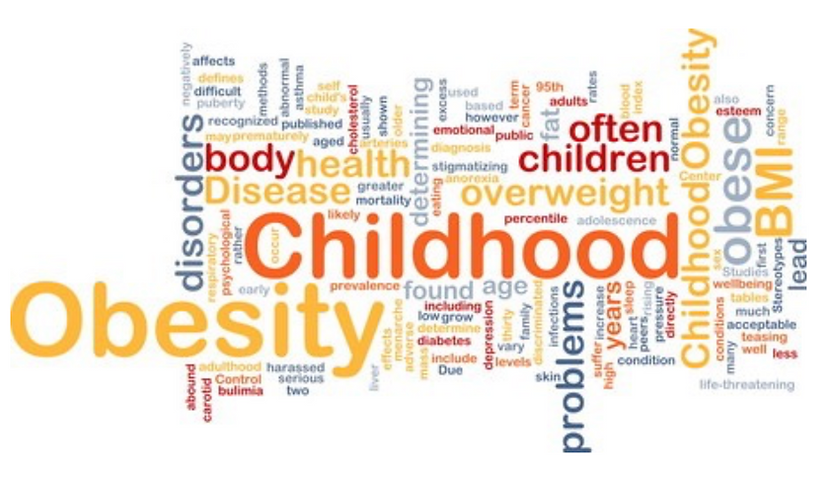Obesity: An Epidemic Affecting Our Children
"Obesity now affects 1 in 5 children and adolescents in the United States." (CDC)


Currently the statistics show:
The prevalence of Obesity, 18.5%
Affecting 13.7 million children & adolescents
Among 6-11 year olds 18.4%
Among 12-19 year olds 20.6%
Webster’s dictionary defines obesity as “A condition characterized by the excessive accumulation and storage of fat in the body. Obesity affects not just appearances, but disease processes as well.”

Defining Childhood Obesity with BMI
Body mass index (BMI) is a measurement used to determine if a child is overweight or obese. The CDC defines being overweight with a BMI at or above the 85th percentile, and below 95th percentile for children and teens with the same sex and age ranges. Obesity is defined as being at or above the 95th percentile of children/teens of same age and sex. As children age their body composition will vary. This is why the BMI levels among children and teens are expressed using percentiles, relative to other kids within the same age range and sex. (CDC)

Calculating BMI
Divide a person weight in kilograms by the square of height in meters.
“For example, a 10-year-old boy of average height (56 inches) who weighs 102 pounds would have a BMI of 22.9 kg/m2. This would place the boy in the 95th percentile for BMI, and he would be considered as obese. This means that the child’s BMI is greater than the BMI of 95% of 10-year-old boys in the reference population.”(CDC)
The Center of Disease Control and Prevention has a wonderful child and teen BMI calculator.

CDC Growth Charts commonly used to measure growth patterns of children and teens in the United States. BMI-for-age weight status and corresponding percentiles are based off expert recommendations, shown in following table:


Factors leading to the Obesity:
Factors can work in combination with another to increase your child’s risk of becoming overweight or obese. Some of these are listed below, but are not limited to
Diet - over eating high-calorie foods and beverages, such as fast foods, soda, candy, and desserts.
Lack of exercise - if children are not exercising they do not burn calories, and are more likely to gain weight.
Family factors - if there is family members who are overweight, the child may be more susceptible to weight gain, especially when high calorie foods are around.
Psychological factors - personal, parental, and family stress can trigger over eating in some children as a coping mechanism or to fight boredom
Socioeconomic factors - some communities have limited resources and access to grocery stores and supermarkets. This increases the chance to rely on convenience foods that will not spoil as quickly.
Childhood obesity. (2018, December 05). Retrieved May 4, 2019, from https://www.mayoclinic.org/diseases-conditions/childhood-obesity/symptoms-causes/syc-20354827

Consequences of Obesity
“Overweight and obese children are likely to stay obese into adulthood and more likely to develop non-communicable diseases…..” (Sahoo, et al)
Physiological Consequences of Obesity not limited to:
Diabetes
Atherosclerosis
Dyslipidemia
High Blood Pressure
Gallbladder disease
Asthma
Allergies
Psychological Consequences of Obesity not limited to
Depression
Anxiety
Low self-esteem
Behavior problems
Poor academic performance
Negative stigmatization
Body Dissatisfaction
References
Childhood Overweight and Obesity | Overweight & Obesity | CDC. (n.d.). Retrieved May 4, 2019, from https://www.cdc.gov/obesity/childhood/index.html
Childhood obesity. (2018, December 05). Retrieved May 4, 2019, from https://www.mayoclinic.org/diseases-conditions/childhood-obesity/symptoms-causes/syc-20354827
Consequences of Childhood Obesity. (n.d.). Retrieved May 4, 2019, from http://frac.org/obesity-health/consequences-childhood-obesity
National Center for Health Statistics. (2010, June 04). Retrieved May 4, 2019, from https://www.cdc.gov/nchs/data/hestat/obesity_child_07_08/obesity_child_07_08.htm
Obesity. (n.d.). Retrieved May 4, 2019, from https://www.merriam-webster.com/dictionary/obesity
Sahoo, K., Sahoo, B., Choudhury, A. K., Sofi, N. Y., Kumar, R., & Bhadoria, A. S. (2015, April). Childhood obesity: Causes and consequences. Retrieved May 4, 2019, from pmc/articles/ PMC4408699/